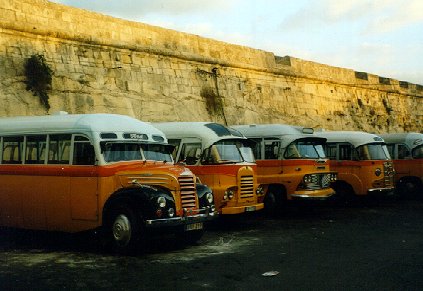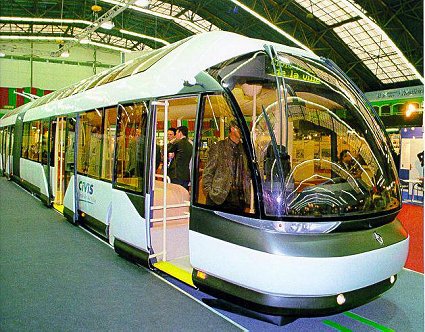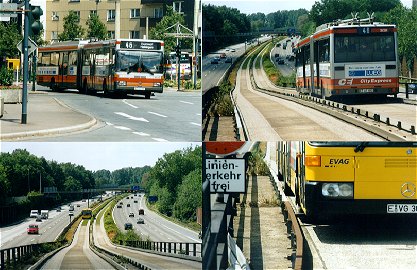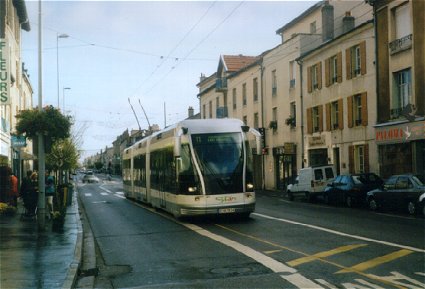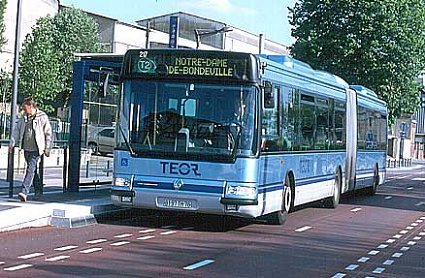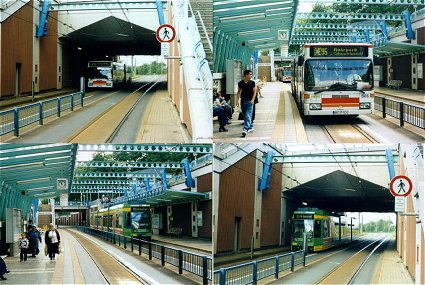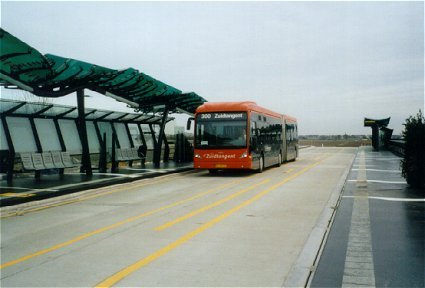FEATURING...
by Rob van der Bijl
Buses are boring and trains are sexy?
J.H. Crawford contra Lloyd Wright
"People like trains, and use them"Are there many differences between buses and light rail? Yes! Do they provide similar performences? No! Or as a mayor of Los Angeles once replied: "Buses are boring. Trains are sexy."
Not boring buses (Malta)Boring or sexy, cheap or expensive, poor or comfortable? A bus is not simply a train or a light rail vehicle! Both represent modes of transportation in their own right. Nevertheless light rail and similar rail-based modes have proved to be very successfull in many cases.
In the words of J.H. Crawford (editor of Carfree Times): "In the end, they're still buses. The fiction was maintained that bus rapid transit can often provide similar performance to light rail. The reality is that people will switch to rail vehicles in much larger numbers than anticipated. People will avoid buses, no matter how you dress them up. It's just not a comfortable way to travel."
Two visions
Lloyd Wright (of the Institute for Transportation & Development Policy) however does have some concern regarding the vision of Crawford:
"Given the success of Bus Rapid Transit (BRT) throughout Latin America (Curitiba, Bogotá, Quito, etc.), the 17-city US programme, the 5-city Australian programme, and the Canadian efforts, I think it is a bit unfair to give such a negative impression to this option. In many respects, BRT does emulate rail-like performance (e.g., São Paulo's Nove de Junho corridor is recording volumes over 50,000 passengers per hour per direction). Of course, one aspect of BRT that is different from rail is its price tag. BRT systems are constructed for US$1 million to US$10 million per kilometer, a fraction of heavy-rail systems.
Yes, the image issue of bus travel does need to be addressed, especially in developed nations. Thus, the BRT programme in the USA emphasizes rail-like vehicles from such manufacturers as Neoplan and Civis.
However, in the developing nations, BRT does not necessarily have such an image problem. The citizens and municipal leaders in Curitiba and Bogotá would not agree with the assessment that they have an inferior product. In fact, Bogotá's new TransMilenio system is far superior to most rail systems that I have experienced.
In the end, it may not even be a strict choice between BRT or rail, as São Paulo has shown that the two options are mutually complementary, with a subway serving the urban core and busways connecting to other areas. At the very least, we should give this promising option a fair chance to prove itself."
CIVIS complementary where money is tight?Carfree Times editor Crawford replies in his newsletter (Issue 23, January 2002): "As readers of this newsletter will be aware, the editor strongly favors rail-based urban transport systems because of their very high energy efficiency, good speed, and high levels of passenger comfort. This is not to say that buses do not have their place, especially in cities where money is very tight. It is interesting to note, however, that Curitiba, which pioneered the advanced bus systems supported by Mr. Wright, is now considering the conversion of some routes to light rail, presumably because of the lower operating costs, reduced pollution, and increased capacity.
It is worth noting that street-running light rail systems can often be installed for a price that falls within the range quoted by Mr. Wright. There is, of course, no question that the ability of conventional buses to run both on and off the BRT network does add a great deal of flexibility to this system, which may be very useful in some circumstances.Recent US experience with bus and rail systems seems to suggest that ridership projections for bus-based systems are consistently too high, whereas ridership projections for new urban rail systems are often exceeded by large margins. People like trains, and use them."
And yes, one have to agree with Crawford that rail-based public transport is very promising. But buses will play their role for sure. Light rail is almost never usefull as a stand-alone system. The benefits of a light rail application only bears fruit if it is part of a larger network of buses, or buses and other modes of transportation.
Guided bus in Essen (D): hopeless
Experiments
In the past there were some hopeless experiments to add light rail-properties to buses. These experiments weren't very succesfull, as the Essen-case in Germany still shows today. A high quality tramway to the housing area of Kray was sacrified for a guided bus showcase. Today only the medium strip alignment survived. The trolley isn't used anymore since dual running in the tram tunnel is finished due to practical and safety reasons.
So far the Nancy fake-tram didn't perform properly
Today again experiments are taken place. And again one tries to add light rail-properties to buses, such as is the case in Nancy (France). Here a bus is disguised as 'rubbertired tram', which is in fact a mechanical guided trolley bus. Many accidents have occured due to the yet immature technology. Other projects in France - such as Translohr and CIVIS - still have to prove their usefullness.
This Rouen bus is 'reading' the dots on the roadThe optical guided bus in east-west corridor in Rouen deserves the benefits of the doubt. The line is numbered T2, while T1 is already in use for the tramway network of the north-south corridor. Unfortunately to much money was spent to the tram tunnel in the centre. Only money for cheaper CIVIS-based public transport remained.
Buses AND Trains
Oberhausen (D): trams AND busesOberhausen shows how tram and bus can merge usefully and successfully. In this German city they use the same infrastructure. Both contribute to a better public transport in the urban Ruhr-region in Germany. Oberhausen proves the usefullness of a merger between 'buses and trains' as feature of a network, in stead of a vehicle!
Zuidtangent (NL): Bus preludes light railIn the United States and Europe many 'HOV-lanes' or 'quality bus corridors' are implemented when light rail isn't (yet) sensible. A nice example in The Netherlands is the recently opened 'Zuidtangent' bus corridor in the region of Amsterdam. This bus infrastructure is already prepared for future light rail use.
Conclusion: 'quality bus corridors' aren't boring, but they are usefull. Buses are not trains or trams; experiments which deny this fact are boring and a waste of money. In the meantime light rail still is sexy.
Thanks to Carfree Times (J.H. Crawford) www.carfree.com
All photos: (C) RVDB/LRA, 2002
Mail LRA your questions and comments.
